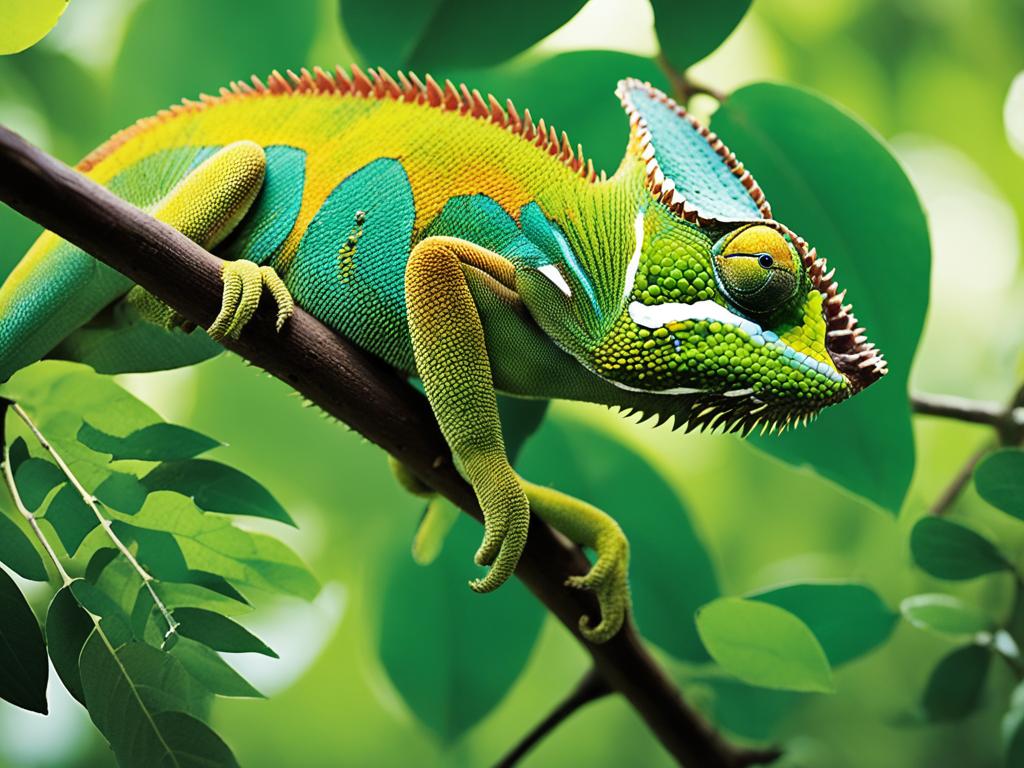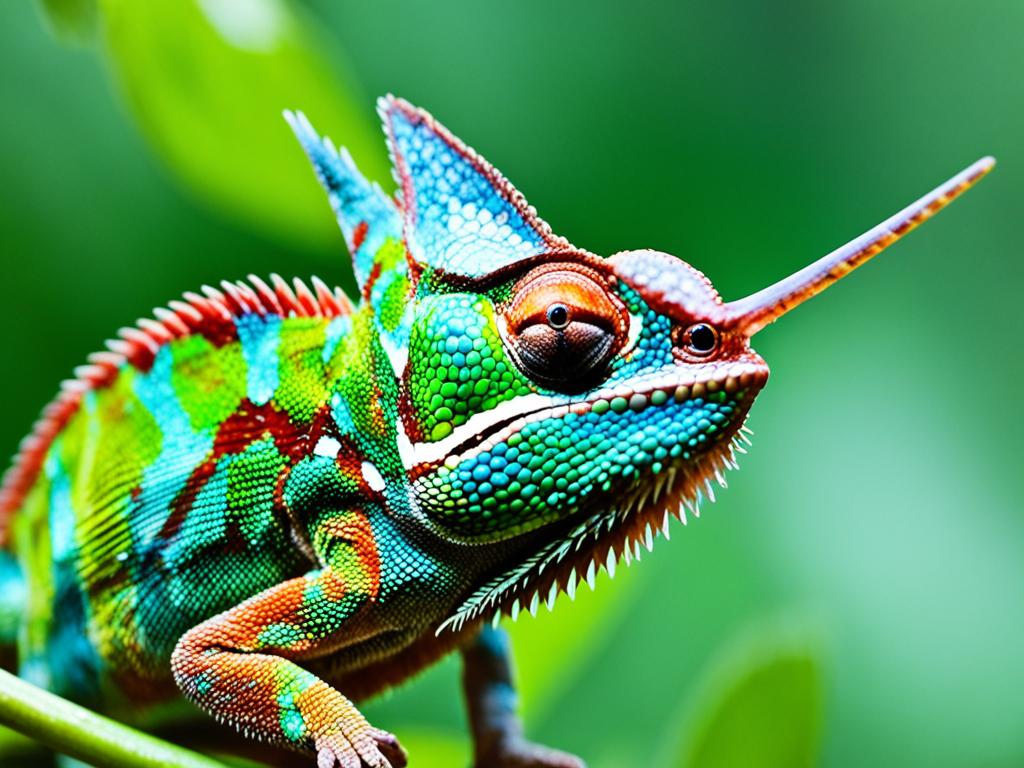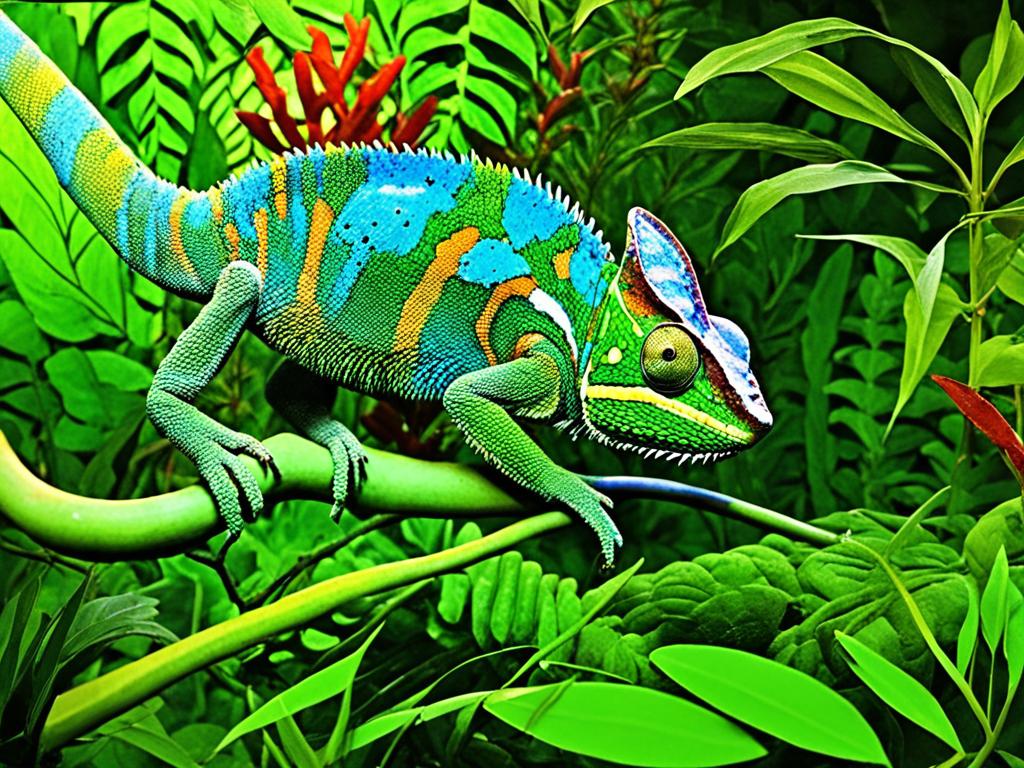Do you remember that feeling of pure enchantment as a child? The kind that made your heart skip a beat and your imagination soar? Imagine capturing that feeling and bringing it into your everyday life. Sounds magical, doesn’t it?
Well, now you can. Welcome to the world of raising chameleons – a realm where wonder and fascination converge. These mesmerizing creatures have the power to transport you to a world filled with vibrant colors, intricate patterns, and intriguing behaviors.
Whether you’re a seasoned chameleon enthusiast or new to the world of reptiles, this comprehensive guide will provide you with the knowledge and tools to create a captivating home for your chameleon companion. From care tips to habitat setup, feeding guides to health issues, we’ve got everything covered to ensure your chameleons thrive in their magical world.
Key Takeaways:
- Discover the enchanting world of raising chameleons and create a magical connection with these captivating creatures.
- Learn essential care tips and information for establishing a vibrant and thriving habitat for your chameleon.
- Understand the unique characteristics, behavior, and special adaptations of different chameleon species.
- Gain insights into feeding guidelines, health issues, and breeding tips to ensure the well-being and happiness of your chameleons.
- Design an enchanting chameleon enclosure that combines beauty and functionality for maximum delight.
Understanding Chameleons: A Fascinating Species
Before diving into the world of chameleon care, it’s important to understand these fascinating reptiles. Chameleons belong to the family Chamaeleonidae and are known for their unique ability to change color. With their captivating appearance and intriguing behavior, chameleons make for one-of-a-kind pets.
There are numerous chameleon species, each with its own distinct characteristics and natural habitats. Let’s take a closer look at some popular chameleon species:
Veiled Chameleon (Chamaeleo calyptratus)
The veiled chameleon, also known as the Yemen chameleon, is native to the Arabian Peninsula. It is recognized for its large casque (a horn-like projection on the head), vibrant colors, and ability to change patterns. Veiled chameleons are arboreal and thrive in well-vegetated habitats.
Panther Chameleon (Furcifer pardalis)
The panther chameleon is one of the most visually stunning chameleon species. Native to Madagascar, it exhibits a fascinating range of colors, including vibrant reds, blues, greens, and yellows. Besides its colorful appearance, the panther chameleon is known for its independent nature and territorial behavior.
Jackson’s Chameleon (Trioceros jacksonii)
Jackson’s chameleon, named after the famous herpetologist Wilhelm Jackson, can be found in the mountainous regions of East Africa. This species features three prominent horns on its head and comes in various colors, including green, red, and yellow. Jackson’s chameleons are known for their slow-paced, deliberate movements.
These are just a few examples of the mesmerizing chameleon species that exist. Each species has its own specific requirements when it comes to habitat, temperature, lighting, and diet. Understanding the unique characteristics of different chameleon species is essential for providing them with optimal care.
Chameleons have evolved several special adaptations to survive in their natural environments:
- Prehensile tail for grasping branches and stabilizing their bodies.
- Independent eye movement, allowing them to scan their surroundings without moving their heads.
- Exceptional tongue projection to capture prey with lightning-fast accuracy.
- Extremely flexible and zygodactylous feet, enabling them to grip onto various surfaces.
Chameleons are truly remarkable creatures and are sure to captivate any reptile enthusiast.
| Chameleon Species | Natural Habitat | Distinctive Characteristics |
|---|---|---|
| Veiled Chameleon | Arabian Peninsula | Large casque, vibrant colors, and pattern-changing ability |
| Panther Chameleon | Madagascar | Visually stunning colors, independent nature, territorial behavior |
| Jackson’s Chameleon | East Africa | Three prominent horns, various colors, slow-paced movements |
Creating the Perfect Chameleon Habitat
When it comes to raising chameleons, creating the perfect habitat is essential for their well-being and happiness. By providing a comfortable and appropriate environment, you can help your chameleon thrive and display their natural behaviors. Here’s a step-by-step guide to setting up the ideal chameleon habitat:
1. Choosing the Right Enclosure
Start by selecting a suitable enclosure that will accommodate your chameleon’s size and needs. With a variety of options available, such as glass terrariums or screen cages, consider the ventilation requirements and space for climbing and basking.
2. Setting the Ideal Temperature and Humidity Levels
Chameleons are ectothermic reptiles, relying on external heat sources to regulate their body temperature. Ensure that the habitat has a warm basking spot of 85-90°F (29-32°C) and a cooler area around 75-80°F (24-27°C) for thermoregulation. Additionally, maintaining humidity levels between 50-70% is crucial for their health and shedding process.
3. Providing Proper Lighting
Chameleons require both UVA and UVB lighting to simulate natural sunlight. Use full-spectrum UVB bulbs specifically designed for reptiles, ensuring they are placed within an appropriate distance from the basking spot to provide sufficient exposure.
4. Creating a Naturalistic Environment
Enhance your chameleon’s habitat with live plants, branches, and vines to mimic their natural surroundings. Not only do these elements offer hiding spots and climbing surfaces, but they also contribute to the overall aesthetic appeal of the enclosure.
5. Offering Enrichment and Stimulating Activities
Keep your chameleon active and engaged by providing enrichment activities. This can include introducing safe and interactive toys, placing live feeders for hunting stimulation, and occasionally rearranging the habitat to encourage exploration.
Remember to regularly monitor the temperature, humidity, and lighting levels within the habitat to ensure they remain within the appropriate ranges. Regular cleaning and maintenance is also crucial in preventing the buildup of bacteria and parasites.
By following these steps for chameleon habitat setup, you can create a comfortable and captivating environment that mirrors their natural habitat. Let your creativity flourish while prioritizing your chameleon’s needs, and you’ll provide them with a truly enchanting home.

Nourishing Your Chameleon: A Proper Feeding Guide
Feeding a chameleon requires careful consideration of their dietary needs. As insectivores, chameleons thrive on a diet rich in live insects and occasional plant matter. Providing them with a balanced and nutritious diet not only ensures their overall health but also enhances their vibrant colors and vitality.
Types of Insects for Chameleons
When it comes to feeding your chameleon, choosing the right insects is crucial. Offer a variety of small, gut-loaded insects such as crickets, roaches, and mealworms. These insects should be nutritious and appropriately sized for your chameleon’s age and size. Gut-loading involves feeding the insects a nutritious diet before feeding them to your chameleon, ensuring they receive optimal nutrition.
Feeding Frequency
Chameleons are opportunistic feeders and require regular meals. For young chameleons, offer small meals daily, gradually decreasing the frequency as they mature. Adult chameleons typically require feeding every other day, accompanied by a variety of appropriately-sized insects. Remember to monitor their appetite and adjust the frequency of feeding accordingly, as individual chameleons may have different needs and preferences.
Plant Matter for Chameleons
In addition to insects, chameleons can benefit from consuming leafy greens and fruits. Offer a selection of safe plants such as dandelion greens, collard greens, and hibiscus flowers. These plant materials provide essential vitamins and minerals, contributing to your chameleon’s overall wellness. Keep in mind that plants should be thoroughly washed and free from pesticides or harmful chemicals.
To ensure your chameleon receives a well-rounded diet, consider dusting the insects with a calcium and vitamin supplement. This helps prevent calcium deficiency and promotes optimal bone health. However, it’s important to follow the recommended dosage and frequency provided by reputable sources, as excessive supplementation can be harmful.
Proper nutrition is key to the health and well-being of your chameleon. By offering a varied diet of gut-loaded insects and appropriately-sized plant matter, you can provide a nourishing and stimulating feeding experience for your enchanting pet.

Summary
By following a proper feeding guide, you can ensure your chameleon receives the nutrients they need to thrive. Offer a diverse range of live insects, gut-loaded for optimal nutrition, along with safe and washed plant matter. Don’t forget to incorporate calcium and vitamin supplementation as recommended.
Maintaining Chameleon Health: Addressing Common Issues
Just like any other pet, chameleons can face health issues. It’s essential for chameleon owners to be aware of common health problems that can affect these captivating reptiles in order to provide them with the best care possible. By understanding the signs to watch for, taking preventative measures, and seeking proper veterinary care when needed, you can help ensure a happy and healthy chameleon companion.
Signs of Chameleon Health Issues
Chameleons are masters of disguise, making it challenging to detect health issues at times. However, there are several signs that may indicate something is amiss with your chameleon’s health. Keep an eye out for the following:
- Loss of appetite or weight loss
- Lethargy or lack of energy
- Abnormal droppings, such as diarrhea or excessive urination
- Difficulty breathing or wheezing
- Changes in coloration, such as a pale or dull appearance
- Swelling or lumps
If you notice any of these signs, it’s crucial to take prompt action and address the potential health issue. Early detection and intervention can often lead to better outcomes.
Preventing Chameleon Health Issues
Prevention plays a key role in maintaining chameleon health. By ensuring your chameleon’s habitat is set up correctly, providing a balanced diet, and practicing good hygiene, you can minimize the risk of health problems. Here are some preventative measures to consider:
- Create a suitable habitat with appropriate temperature and humidity levels
- Provide a varied and nutritious diet consisting of insects and plants
- Avoid overfeeding and ensure proper supplementation
- Regularly clean and disinfect the enclosure to prevent the growth of harmful bacteria
- Handle your chameleon with care to prevent injuries
By implementing these preventative measures, you can significantly reduce the likelihood of your chameleon encountering health issues.
Providing Proper Veterinary Care
Regular veterinary check-ups are essential for maintaining your chameleon’s health. A reptile-savvy veterinarian can conduct thorough examinations, provide necessary vaccinations, and offer guidance on chameleon-specific health concerns. They can also perform diagnostic tests if needed to identify and treat any underlying conditions.
“Regular veterinary check-ups are a cornerstone of responsible chameleon ownership. Your veterinarian can serve as a valuable resource in ensuring your chameleon’s health and wellbeing.”
If you suspect your chameleon may be unwell or are unsure about any aspect of their health, it’s crucial to consult with a reptile veterinarian promptly. They can provide expert advice and tailor treatment plans to meet your chameleon’s specific needs.
| Common Chameleon Health Issues | Symptoms | Treatment |
|---|---|---|
| Metabolic Bone Disease (MBD) | Fragile bones, swollen joints, twitching muscles | Calcium and vitamin D3 supplementation, UVB lighting |
| Respiratory Infections | Labored breathing, wheezing, mucus discharge from nose or mouth | Antibiotics, supportive care, environmental adjustments |
| Parasites | Weight loss, diarrhea, lack of appetite | Parasite-specific medications, hygiene practices |
| Dehydration | Sunken eyes, wrinkled skin, lethargy | Fluid therapy, increased humidity levels |
| Eye Infections | Redness, swelling, discharge, difficulty in keeping eyes open | Antibiotics, eye drops, proper hygiene |
It’s important to note that each chameleon is unique, and their health needs may vary. Consulting with a qualified veterinarian is crucial for accurate diagnosis and development of an appropriate treatment plan.
Breeding Chameleons: Tips for Success
Ready to venture into the world of chameleon breeding? If you’ve mastered the basics of chameleon care and feel confident in your ability to provide a nurturing environment, breeding chameleons can be a rewarding and educational experience. This section will provide you with valuable chameleon breeding tips to ensure your breeding endeavors are successful and contribute to the conservation of these captivating creatures.
Creating the ideal breeding environment is crucial for successful chameleon breeding. Start by ensuring the chameleons have a spacious and well-maintained enclosure with proper temperature and humidity levels. Provide plenty of hiding spots and branches for the female to lay her eggs, as well as a separate nesting box where the eggs can be incubated.
It’s important to observe the behavior of your chameleons closely to identify signs of readiness for breeding. Male chameleons may exhibit territorial or aggressive behavior when they are ready to mate, while females may become more receptive to the male’s advances. Keep track of their feeding patterns and note any changes in behavior.
Once you’ve identified that your chameleons are ready to breed, you can introduce the male to the female’s enclosure. However, it’s essential to supervise their interactions closely to prevent any aggressive behavior or stress. Remove the male if aggression is observed, as it can be harmful to both chameleons.
Patience is key during the breeding process, as chameleons may take time to establish a bond and mate successfully. Provide a calm and stress-free environment, and avoid handling or disturbing the chameleons unnecessarily. Allow them to establish their own rhythm and timing for successful breeding.
Once the female has laid her eggs, it’s essential to provide the appropriate incubation conditions. Research the specific requirements for your chameleon species and ensure the eggs are kept at the optimal temperature and humidity levels. Regularly monitor the eggs for any signs of fungal growth or damage.
Remember that responsible breeding practices contribute to the conservation of chameleons. Avoid excessive breeding and ensure that you have suitable homes for any offspring before embarking on a breeding journey. Consider sharing your knowledge and experiences with others to encourage responsible chameleon breeding.
With these chameleon breeding tips in mind, you can embark on a successful breeding journey and contribute to the preservation of these enchanting creatures. Remember to always prioritize the well-being of your chameleons and provide them with the care they need throughout the breeding process.
Learn more about mountains and their ecosystems to gain a deeper understanding of the natural habitats that chameleons are adapted to.
Designing an Enchanting Chameleon Enclosure
Creating a captivating and functional chameleon enclosure is an essential aspect of chameleon care. Not only does a well-designed enclosure provide a visually appealing space for your colorful pet, but it also ensures their overall well-being. When it comes to chameleon enclosure design, there are key elements that you should consider to create a harmonious and enchanting habitat.
1. Selecting the Right Materials
Choosing the right materials for your chameleon enclosure is crucial for its durability and functionality. Opt for materials that are sturdy, easy to clean, and non-toxic. The enclosure should have proper ventilation to maintain the desired temperature and humidity levels. Consider using PVC, glass, or screen enclosures, depending on the specific needs of your chameleon species.
2. Incorporating Natural Elements
To create an enchanting environment for your chameleon, it’s important to incorporate natural elements within the enclosure. Arrange live plants strategically to provide hiding spots and climbing opportunities for your chameleon. Research the specific plant species that are safe for chameleons and create a lush and vibrant habitat that mimics their natural surroundings.
3. Implementing Effective Ventilation
Proper ventilation is crucial in maintaining a healthy and comfortable chameleon enclosure. Ensure that the enclosure has adequate airflow to prevent stagnant air and excess humidity, which can lead to respiratory problems. You can achieve effective ventilation by incorporating vents or mesh panels in the enclosure design.
4. Creating Functional Spaces
A well-designed chameleon enclosure should provide functional spaces to meet your pet’s needs. Include various branches, vines, and platforms at different heights to allow your chameleon to explore and bask under the heat and UVB lighting. Make sure that these spaces are easily accessible and provide opportunities for your chameleon to exercise and exhibit natural behaviors.
Learn more about chameleon enclosure design tips and tricks here.
Designing an enchanting chameleon enclosure requires careful consideration of the chameleon’s natural habitat and needs. By selecting the right materials, incorporating natural elements, implementing effective ventilation, and creating functional spaces, you can provide an enchanting and comfortable home for your chameleon companion.
Conclusion
In conclusion, exploring the enchanting world of raising chameleons can be a truly magical experience. By following the comprehensive tips and guidance provided in this guide, you can create a captivating and comfortable habitat for your chameleon, ensure proper feeding and care, and establish a rewarding companionship. The unique beauty and behavior of these reptiles will constantly amaze and inspire you.
Embracing the delight of raising chameleons allows you to immerse yourself in a world of wonder. Witness their stunning color changes, observe their fascinating hunting techniques, and marvel at their incredible ability to blend into their surroundings. From mesmerizing species to the intricate design of their enclosure, every aspect of caring for a chameleon is both fulfilling and enriching.
So, whether you are a first-time chameleon owner or a seasoned enthusiast, remember to approach the care of these captivating creatures with dedication and a sense of adventure. As you provide them with the ideal environment and nurture their well-being, you will embark on an extraordinary journey that will deepen your appreciation for the natural world and the wonders it holds.




